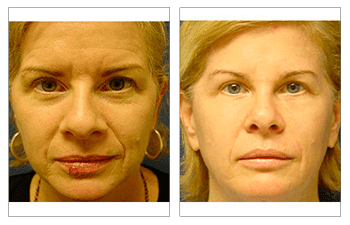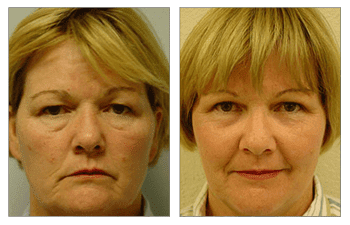


Introduction: Fat transfer for female faces Cosmetic Plastic Surgery
Fat transfer for female faces requires intimate knowledge of female face ideals. This begins with appreciating that the rejuvenated female face contour should mimic that of a heart. That means that the face should have a rounded upper outer contour that is maximally full at the level of the cheekbone, i.e. zygomatic arch, which then transitions to a narrowed lower chin region.
The transition from the upper to the lower face must be smooth and much like the shape of a heart. As the female face ages, it will actually lose volume as fat atrophies over time. This is counterintuitive to other areas of the body which tend to increase in fat volume with the slowing of your metabolism.
Regardless, with loss of fat volume in the face not only does sagging of the redundant facial skin occur, but also fullness is lost from the upper, outer face as it bunches up along the jawline over the lower face changing the facial shape into a spade. This undesirable shape is in contrast to the desired heart-shaped facial structure The goal of fat transfer for female faces involves transforming the aged spade shape to a youthful heart shape. This is accomplished with generous fat transfer to the face that may include the lateral orbital rim, around the eyes, the temples, and the lateral cheeks.
There is also an area over the medial cheek, described as the nasojugal groove that when deepened will create slack of the medial cheek, thus improving the appearance of the nasolabial folds. Fat transfer for female faces can expect to have up to 30cc of fat injected routinely to achieve a more rejuvenated appearance. Now, let us discuss the details regarding facial fat grafting.
What is Facial Fat Grafting?
Facial Fat Grafting is a cosmetic procedure that involves transferring fat from one part of the body to the face to restore volume and create a more youthful appearance. The procedure typically requires local anesthesia or sedation to ensure minimal discomfort.
The first step involves the removal of fat from a donor site, usually the abdomen or thighs, through liposuction. The extracted fat is then purified to separate it from blood, oils, and other fluids.
Once purified, the fat is carefully injected into the desired areas of the face to improve volume and contour. The entire procedure typically takes around 1-2 hours, depending on the extent of augmentation required.
One potential concern with Facial Fat Grafting is the reabsorption of the injected fat by the body. To account for this, a slightly greater amount of fat is injected than needed, as some of it will be naturally absorbed over time.
Overall, the surgery duration and potential reabsorption should be discussed with the surgeon beforehand. Facial Fat Grafting can provide long-lasting results, with the body eventually integrating the transferred fat cells.
Why Get a Fat Graft for the Face?
Facial fat grafting, also known as fat transfer, is a popular procedure for facial rejuvenation due to its numerous benefits. It involves transferring fat from one part of the body to the face to restore volume, improve contours, and rejuvenate the skin. The areas of the face where fat can be transferred include the cheeks, forehead, temples, and around the eyes and mouth. Fat grafting can also be used in conjunction with other procedures such as facelifts or eyelid surgeries to enhance the results and achieve a more natural and youthful appearance.
The procedure of facial fat grafting is typically done under local anesthesia and involves the removal of fat from a donor area, such as the abdomen or thighs, followed by purification and injection into the desired areas of the face. Using your own fat for facial rejuvenation has advantages such as long-lasting results, minimal risk of allergic reactions, and the added benefit of body contouring in the donor area.
In summary, getting a fat graft for the face offers a natural and long-lasting solution for facial rejuvenation, with the added benefit of potential body contouring in the donor area. It is a safe and effective procedure that can be tailored to address specific areas of concern on the face.
Who is A Good Candidate?
A good candidate for fat transfer is someone who is in good overall health, at a stable weight, and has realistic expectations for the procedure. They should be a non-smoker and have sufficient fat in the donor areas for the transfer. Good candidates understand that fat transfer is not a quick fix and may require additional procedures for optimal results. Good circulation and sufficient fat cells are crucial for a successful fat grafting procedure, as they ensure the survival and integration of the transferred fat.
Facial areas that can be improved with fat transfer include sunken areas such as the cheeks and under-eye area, lines and wrinkles, and scarring from previous trauma or acne. By taking fat from one area of the body and strategically injecting it into the face, a plumper, more youthful appearance can be achieved. Overall, a good candidate for fat transfer is someone who is in good health, has realistic expectations, and has sufficient fat for the transfer to be successful and achieve optimal results.
How is Facial Fat Grafting Done?
Facial fat grafting is a procedure used to rejuvenate and add volume to the face by transferring fat from one part of the body to the face. The procedure is typically performed under local anesthesia to numb the areas where the fat will be harvested and injected.
First, a small incision is made in the donor area, often the abdomen or thighs, and a liposuction cannula is used to extract the fat. The harvested fat is then carefully purified to remove any blood, oil, or other non-fat substances.
Once purified, the fat is then injected into the desired areas of the face using a small cannula. The importance of proper placement of the fat cells cannot be overstated as it maximizes the potential for nutrition from blood circulation, ensuring the survival and successful integration of the grafted fat.
The injection process involves meticulous layering of the fat to ensure natural-looking results and to prevent the formation of lumps or bumps. The exact technique and specific areas targeted for fat grafting may vary based on each patient’s unique facial anatomy and aesthetic goals. Proper placement of the fat cells is crucial for achieving optimal and long-lasting results.
What is Recovery Like?
Recovery after facial fat injections typically involves common symptoms such as swelling, bruising, and some discomfort. In the first week, patients can expect moderate swelling and bruising, along with mild pain at the injection sites. By the second week, the swelling and bruising should start to improve, and any discomfort should lessen. By the fourth week, significant improvement in swelling and bruising can be observed, with the final results becoming more apparent.
It’s essential to follow post-operative care instructions, such as applying cold compresses and avoiding high-impact activities, to aid in proper healing. Avoiding high-impact activities is crucial to prevent any disruption to the injected fat cells and allows them to settle into their new position for optimal results. Overall, the recovery timeline for facial fat injections typically involves a gradual improvement in symptoms over the course of four weeks, with final results becoming more evident in the following months.
What Are the Risks of Facial Fat Grafting?
Facial fat grafting, like any surgical procedure, carries several potential risks. These include the risk of infection, bleeding, changes in skin sensation, fat embolism, and the possibility of undesirable results such as asymmetry or overcorrection. To reduce these risks, it is crucial to select a Board Certified Plastic Surgeon with extensive experience in facial fat grafting. Additionally, following the pre and post-operative instructions provided by the surgeon is essential for minimizing risk and maximizing the success of the procedure.
During the consultation, the surgeon will discuss the risks in more detail and may suggest alternative procedures if needed to minimize the potential risks and achieve the desired outcomes. It is important to have a thorough understanding of the risks involved in facial fat grafting and to have an open and honest conversation with the surgeon to address any concerns. By choosing a skilled and qualified surgeon and following their guidance, the risks associated with facial fat grafting can be minimized, and the likelihood of a successful outcome can be greatly increased.
Facial Fat Transfer vs Dermal Fillers
Facial fat transfer involves the harvesting of fat from one part of the body and injecting it into the face to add volume and rejuvenate the skin. This natural procedure typically lasts longer, as the results can be permanent. Dermal fillers, on the other hand, are synthetic substances injected into the face to restore volume and reduce the appearance of wrinkles. The results of dermal fillers typically last between 6 months to 2 years, depending on the specific filler used.
Facial fat transfer uses the body’s own natural fat, resulting in a more natural look and feel, while dermal fillers use synthetic substances. Facial fat transfer can address concerns related to volume loss, while dermal fillers can address specific wrinkles and lines in the face.
The advantages of facial fat transfer include longer-lasting results and the use of natural substances, while the disadvantages include a longer recovery time and the need for a surgical procedure. Dermal fillers have the advantage of being non-surgical and providing immediate results, but they may need to be repeated more frequently and can carry a risk of side effects such as bruising and swelling.
Ultimately, the decision between facial fat transfer and dermal fillers will depend on individual concerns and preferences for the duration of results and the use of natural vs synthetic substances.
Conclusion: Fat Transfer for Female Faces Cosmetic Plastic Surgery
If you have considered undergoing fat transfer for female faces cosmetic plastic surgery we encourage you to contact SurgiSculpt to complete a facial evaluation. Following your consultation, you will have a better idea regarding the volumes and precise location of fat transfers that will be completed for you.
Please see this 52-year-old female 3 months following facial fat grafting, Erbium facial resurfacing, and lower blepharoplasty.
